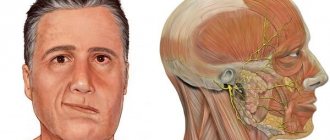Mutism is like a dog: I understand everything, but I can’t answer.
The condition is characterized by loss of the ability to speak while maintaining hearing and the functionality of the speech-motor apparatus. The term owes its name to the Latin word mutus, which means “silence.” The pathology occurs in both children and adults, but more often it develops in childhood.
Symptoms of mutism
The main symptoms of mutism include the absence or cessation of speech while the functions of the speech apparatus and brain structures responsible for understanding and reproducing speech structures are preserved. In addition, the following data is collected to make a diagnosis:
- duration of absence of speech, movements, answers to questions;
- the presence of strong emotional turmoil;
- social isolation in behavior;
- expressing your needs and desires with gestures;
- loss of consciousness;
- head injuries;
- facial asymmetry;
- mental retardation and speech disorders;
- strabismus and impaired movements of the eyeballs.
One person does not necessarily have all the symptoms; more often it is a combination of a couple of disorders characteristic of a certain type of mutism.
Complex of therapeutic measures
There is no universal method for treating psychogenic mutism; in each case, methods are selected individually, depending on the patient’s condition and the causes of the disorder. The main goal of treatment is to eliminate the consequences of injury and normalize the patient’s mental state.
As part of therapy, medications from the group of nootropics and antipsychotics are prescribed, and antidepressants may be recommended.
The patient also needs psychotherapeutic treatment, help in getting rid of anxiety and overcoming stress. In addition, additional activities may be prescribed, for example, massage, therapeutic and breathing exercises, etc.
In most cases, mutism of psychogenic origin is treatable, and patients have a good chance of a full recovery and a full life in the future.
Types and causes of mutism
Variants of mutism differ not only in their manifestation, but also in the cause that caused this disorder. The following types of mutism are distinguished:
- Psychogenic – occurs as a result of a traumatic situation or in specific social conditions that cause a child to feel fear or severe anxiety.
- Catatonic – characteristic of catatonic syndrome, represents an unmotivated refusal to communicate (in schizophrenia spectrum disorders).
- Hysterical - a person’s subconscious desire to attract the attention of others, using the loss of speech (with dissociations).
- Akinetic - occurs due to violations of the integrity of brain structures, organic, traumatic or infectious lesions of the brain, tumors, etc.
Separately, selective mutism should be highlighted, when a person is able to communicate with a certain circle of people. This disorder is most common in adults. It occurs in children from the age of three years, when speech is considered formed.
Clinical manifestations and symptoms
Psychogenic mutism can be diagnosed by the presence of certain signs; the main symptoms include:
- refusal of verbal (speech) communication;
- absence of diseases as a result of which speech functions are impaired;
- clarity of consciousness;
- maintaining the ability to express one's thoughts in writing;
- use of non-verbal methods of communication.
If muteness persists for more than 1 month, this indicates mutism. In some cases, a person is unable to communicate only in a state of excitement or loses speech when in contact with a certain circle of people.
Mutism in children
Childhood mutism is initially divided into situational, permanent and total. Typically, the provoking factor for the occurrence of this disorder in childhood is traumatic psychogenic influence and the general psychological climate in the family. Selective childhood mutism occurs between the ages of three and is often first diagnosed at the beginning of school. There are cases when it goes away on its own by the age of ten, but if it is not corrected, the child will develop secondary speech and psycho-emotional disorders: logophobia, logoneurosis, social phobia, low self-esteem, anxiety and other neurotic disorders. Children with mutism, which has not been corrected, have pronounced schizoid and inhibited features, and have difficulties in intellectual development and verbal and logical thinking.
There are no physiological disturbances in this case, so mutism can be perceived as a passive form of protest against new social norms or changes in social conditions.
Psychogenic mutism, which occurs in children as a result of psychological trauma, has a different specificity. This state arises due to the unpreparedness of the psyche to transform the acquired life experience and establish contact with others in the current situation. War events, psychological violence in the family, sexual violence, presence at the death of loved ones, etc. – all this violates the stability of the psyche. This form of mutism is accompanied by an increased level of anxiety, depression, impressionability, and infantilism. There may be disturbances in appetite and sleep, lethargy, and frequent moods of protest.
In the most common forms of childhood mutism, there are no physiological disturbances, so the condition is corrected exclusively by psychotherapeutic methods.
Getting rid of the disorder
Recognizing the symptoms of childhood mutism and treating it poses some challenges. To establish a diagnosis, it is necessary to clearly differentiate the phenomenon from other disorders.
There is no generally accepted treatment regimen for mutism in children. An individual approach is used in each specific case. Possible methods used:
- psychotic drugs to relieve tension, relieve fear;
- physiotherapy to relax the muscles of the neck and speech-motor apparatus, which the child strains in the situation of planned communication;
- psychotherapy. Initially, individual therapy is recommended to establish contact with the little silent one. But in the future, you should still switch to the group form. Being in a team helps to establish social contact and emancipation. Group therapy may take the form of drama. Family psychotherapy is required.
But it is worth understanding that the main step to restoring a child’s speech activity is treating the underlying disease or eliminating a traumatic psychological factor. Therapy must be started as early as possible. The following situations may be indications for contacting a doctor:
- if the baby does not communicate for more than 1 month;
- the presence of speech problems under certain circumstances;
- the child hears and understands what is said to him, his intelligence is preserved. Tries to communicate with gestures and writing;
- absence of speech motor defects.
Children suffering from mutism are a special category. Despite their silence, they understand everything, are distinguished by observation and simply donkey stubbornness. The inability to speak creates tension and unrest in their inner world. They are able to swim in different guises. For example, cases of pronounced cruelty in children have been observed. The boy could come up to his mother and bite her for no reason. Other patients showed cruelty to animals.
The inability to express one's thoughts directly requires treating silent people with increased attention. Early diagnosis and assistance to the child will help to avoid social vacuum and psychosis.
Treatment and correction of mutism
To correct mutism, an integrated approach is used, which involves the coordinated work of several specialists:
- First of all, it is recommended to contact a neuropsychiatrist or child psychotherapist, who will make an accurate diagnosis and, if necessary, prescribe medication.
- Neurologist - prescribes medications and physical procedures that correct the functioning of the brain, and also conducts periodic diagnostics of changes in condition.
- Child psychologist - carries out basic psychotherapeutic work, where communication itself is a stimulating and supportive method for speech and writing, and provides advice on changing the situation in the family. Children benefit greatly from the sand therapy method used by psychologists.
- Speech therapist - conducts classes on the development of the articulatory apparatus in order to prevent or correct speech disorders that arise as a result of long silence.
- The Tomatis hardware method can also be used to reduce anxiety levels. It prevents logophobia and logoneurosis as common consequences of mutism.
All actions of specialists must be coordinated for each specific case. Only one recommendation remains the same - start correction as early as possible.
Diagnostic criteria and methods
In the diagnostic process, in order to most fully assess the patient’s condition, specialists will need information about how long ago the person stopped communicating through speech and as a result of what events this happened. The following examinations are also prescribed:
- magnetic resonance imaging (MRI);
- computed tomography of the brain ();
- electroencephalography (EEG).
In addition, it is necessary to conduct a neurological examination, as well as consult with a psychiatrist and speech therapist.
List of sources
- Osipova A.A. General psychocorrection: textbook. allowance. M.: Sfera, 2002;
- Sidorov P.I., Parnyakov A.V. Introduction to clinical psychology: A textbook for medical students. Volume 1. M. Ekaterinburg: Academic project-Business book; 2000;
- Yakhno N. N., Shtulman D. R. Diseases of the nervous system: A guide for doctors in 2 volumes. - M.: “Medicine”, 2005;
- Konovalova A. N., Skvortsova V. I., Gekht A. B. Neurology: National Guide / Ed. E. I. Guseva. - M.: GEOTAR-Media, 2009.
Preventive measures
There are no specific preventive measures to prevent psychogenic disorders. The reason is that in most cases it is impossible to predict and prevent the emotional shocks and psychological trauma that can trigger the disease.
The only thing that can be done is to monitor your health, which will to some extent increase your mental stability in stressful situations, namely:
- observe a rest regime and avoid emotional and physical overload;
- lead a healthy lifestyle;
- sleep at least 8 hours a day;
- If possible, avoid stressful situations and nervous tension;
- promptly seek medical help for health problems.
When it comes to a child, it is necessary to take care of a calm and comfortable environment in the family, avoid stormy showdowns and not use violence against the child. And if any deviations or behavioral disorders appear, immediately contact a specialist.
HOW TO HELP A CHILD: TIPS FOR PARENTS
- Try not to encourage your child to engage in avoidant behavior from early childhood. For example, if a person a mother knows asks the child his name, then you should not answer for him, even if he hides his face and is silent. Otherwise, the baby will get used to the fact that in a situation of embarrassment and anxiety, his mother will say everything for him. The more often this is repeated, the more likely it is that he will stop talking altogether in situations that are uncomfortable for him. It is better to tell your friend that your daughter or son is not ready to communicate now, but perhaps you will be able to do this later.
- Increase self-esteem. If a child knows from childhood that he is good, that his voice sounds pleasant and no one scolds him for unclear speech, then he most likely will not suffer from mutism. It’s good when he is praised, encouraged, and sometimes admired for what he does and says. When a child from an early age hears several times a day: “your voice is too loud”, “don’t shout”, “don’t distort your words”, “be quiet”, “they didn’t ask you”, then over time he will decide that it’s better not talking than constantly being criticized. He will be afraid of saying something wrong, of making a mistake, or of what he says being unimportant.
- Introduce the child into society as early as possible so that a large number of people does not create a stressful situation for him. Bring them to playgrounds, meet friends, go to holidays and clubs where there are a lot of people. If mutism already exists, then at first try to select companies in which he feels comfortable: familiar children and adults, absence of judgment and ridicule, availability of common topics for communication. Later, gradually add less familiar peers.
- If you have selective mutism, you should not expect speech to appear immediately at the beginning of treatment. For this, a certain time must pass, depending on the individual characteristics of the course of the disease.
- When you find yourself in a new environment or surrounded by strangers, you should let yourself get comfortable a little before you can start communicating. There is no need to immediately force him to talk to everyone who approaches him - this can only worsen his condition.
HOW TO CREATE A COMFORTABLE ENVIRONMENT AT SCHOOL
- In order for a child with selective mutism to feel good at school, it is imperative to inform the teacher about his characteristics. The teacher should know that the child needs time to get used to the new atmosphere.
- Ask the teacher not to force him to answer at the board at first, and to join in joint games and activities. But over time, as you get used to it, you can gradually include it in the life of the class. First, offer to talk and do something together with those guys to whom he is drawn. Then gradually involve other students.
- Ask educational material individually or in the presence of a very small number of classmates, no more than 3-4 people. Later, if the first grader was able to speak in front of them, gradually add other listeners. If the child is silent in the presence of only the teacher, then you can agree to record oral responses on video.
- At first, it is better to assess knowledge and skills based on written work.
- The most important thing is that the teacher must win over the first grader so that he can open up and trust him. A teacher who practices an authoritarian communication style is unlikely to be able to find an approach to a student with such a diagnosis.
- To quickly get used to classmates, it is useful for children to play teaming games. Among them there are many that do not require verbal communication. The child gets to know the children, contacts them tactilely and physically. As a result, they become for him that “circle of people” with whom he can comfortably be and talk.











